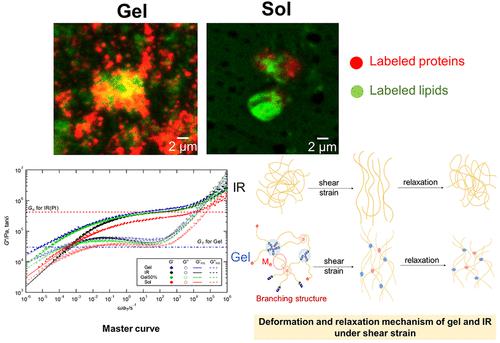当前位置:
X-MOL 学术
›
ACS Appl. Polym. Mater.
›
论文详情
Our official English website, www.x-mol.net, welcomes your
feedback! (Note: you will need to create a separate account there.)
A Model Study of the Influence of the Natural Rubber (NR)- Endogenous Gel Fraction on the Rheological Performance of NR Using Synthetic Polyisoprene Rubber (IR) Blends with Different Ratios of Gel
ACS Applied Polymer Materials ( IF 4.4 ) Pub Date : 2022-09-28 , DOI: 10.1021/acsapm.2c00979 Narueporn Payungwong 1 , Tadashi Inoue 2 , Jitladda Sakdapipanich 1
ACS Applied Polymer Materials ( IF 4.4 ) Pub Date : 2022-09-28 , DOI: 10.1021/acsapm.2c00979 Narueporn Payungwong 1 , Tadashi Inoue 2 , Jitladda Sakdapipanich 1
Affiliation

|
Nonrubber components (NRCs) contribute to the natural networks and endow natural rubber (NR) with exceptional qualities. It is known that the previously proposed NR microstructure has two types of terminal groups, the ω-terminal, which binds to proteins by intermolecular hydrogen bonds, and the α-terminal, which is linked with phospholipids. These connections are believed to be the basis for the formation of naturally occurring networks or gels, which is attributable to the distinctive properties of NR. Using a model of synthetic polyisoprene rubber (IR), the contribution of the gel structure was scrutinized by removing the endogenous gel component derived from NR and adding it in varying quantities to the IR. Through the use of Fourier transform infrared spectroscopy (FT-IR), gel permeation chromatography (GPC), and super-resolution laser scanning confocal microscopy (SR-LSCM), the microstructure of the prepared materials was analyzed. The SR-LSCM analysis revealed that phospholipids exclusively dominated the structure of the sol fraction, whereas both of proteins and phospholipids made up the majority of the gel fraction in NR. The gel microstructure was verified by the GPC analysis, which revealed that short NR chains were networked together. The viscoelastic and mechanical properties of rubber were assessed using an oscillatory shear measurements and tensile testing. The viscoelastic and mechanical performance of the mixed IR with the NR-endogenous gel fraction were strengthened when a substantial proportion of the gel or branch points was incorporated.
中文翻译:

使用不同凝胶比例的合成聚异戊二烯橡胶 (IR) 共混物对天然橡胶 (NR)-内源凝胶分数对 NR 流变性能影响的模型研究
非橡胶成分 (NRC) 有助于形成天然网络,并赋予天然橡胶 (NR) 卓越的品质。众所周知,先前提出的 NR 微结构具有两种类型的末端基团,ω-末端,通过分子间氢键与蛋白质结合,α-末端,与磷脂连接。这些连接被认为是形成天然存在的网络或凝胶的基础,这归因于 NR 的独特特性。使用合成聚异戊二烯橡胶 (IR) 模型,通过去除源自 NR 的内源性凝胶成分并将其以不同数量添加到 IR 中来仔细检查凝胶结构的贡献。通过使用傅里叶变换红外光谱 (FT-IR)、凝胶渗透色谱 (GPC)、和超分辨率激光扫描共聚焦显微镜(SR-LSCM),分析了制备材料的微观结构。SR-LSCM 分析表明,磷脂仅主导溶胶部分的结构,而蛋白质和磷脂均构成 NR 中凝胶部分的大部分。通过 GPC 分析验证凝胶微观结构,这表明短的 NR 链连接在一起。使用振荡剪切测量和拉伸测试评估橡胶的粘弹性和机械性能。当加入相当大比例的凝胶或分支点时,混合 IR 与 NR 内源凝胶部分的粘弹性和机械性能得到加强。SR-LSCM 分析表明,磷脂仅主导溶胶部分的结构,而蛋白质和磷脂均构成 NR 中凝胶部分的大部分。通过 GPC 分析验证凝胶微观结构,这表明短的 NR 链连接在一起。使用振荡剪切测量和拉伸测试评估橡胶的粘弹性和机械性能。当加入相当大比例的凝胶或分支点时,混合 IR 与 NR 内源凝胶部分的粘弹性和机械性能得到加强。SR-LSCM 分析表明,磷脂仅主导溶胶部分的结构,而蛋白质和磷脂均构成 NR 中凝胶部分的大部分。通过 GPC 分析验证凝胶微观结构,这表明短的 NR 链连接在一起。使用振荡剪切测量和拉伸测试评估橡胶的粘弹性和机械性能。当加入相当大比例的凝胶或分支点时,混合 IR 与 NR 内源凝胶部分的粘弹性和机械性能得到加强。通过 GPC 分析验证凝胶微观结构,这表明短的 NR 链连接在一起。使用振荡剪切测量和拉伸测试评估橡胶的粘弹性和机械性能。当加入相当大比例的凝胶或分支点时,混合 IR 与 NR 内源凝胶部分的粘弹性和机械性能得到加强。通过 GPC 分析验证凝胶微观结构,这表明短的 NR 链连接在一起。使用振荡剪切测量和拉伸测试评估橡胶的粘弹性和机械性能。当加入相当大比例的凝胶或分支点时,混合 IR 与 NR 内源凝胶部分的粘弹性和机械性能得到加强。
更新日期:2022-09-28
中文翻译:

使用不同凝胶比例的合成聚异戊二烯橡胶 (IR) 共混物对天然橡胶 (NR)-内源凝胶分数对 NR 流变性能影响的模型研究
非橡胶成分 (NRC) 有助于形成天然网络,并赋予天然橡胶 (NR) 卓越的品质。众所周知,先前提出的 NR 微结构具有两种类型的末端基团,ω-末端,通过分子间氢键与蛋白质结合,α-末端,与磷脂连接。这些连接被认为是形成天然存在的网络或凝胶的基础,这归因于 NR 的独特特性。使用合成聚异戊二烯橡胶 (IR) 模型,通过去除源自 NR 的内源性凝胶成分并将其以不同数量添加到 IR 中来仔细检查凝胶结构的贡献。通过使用傅里叶变换红外光谱 (FT-IR)、凝胶渗透色谱 (GPC)、和超分辨率激光扫描共聚焦显微镜(SR-LSCM),分析了制备材料的微观结构。SR-LSCM 分析表明,磷脂仅主导溶胶部分的结构,而蛋白质和磷脂均构成 NR 中凝胶部分的大部分。通过 GPC 分析验证凝胶微观结构,这表明短的 NR 链连接在一起。使用振荡剪切测量和拉伸测试评估橡胶的粘弹性和机械性能。当加入相当大比例的凝胶或分支点时,混合 IR 与 NR 内源凝胶部分的粘弹性和机械性能得到加强。SR-LSCM 分析表明,磷脂仅主导溶胶部分的结构,而蛋白质和磷脂均构成 NR 中凝胶部分的大部分。通过 GPC 分析验证凝胶微观结构,这表明短的 NR 链连接在一起。使用振荡剪切测量和拉伸测试评估橡胶的粘弹性和机械性能。当加入相当大比例的凝胶或分支点时,混合 IR 与 NR 内源凝胶部分的粘弹性和机械性能得到加强。SR-LSCM 分析表明,磷脂仅主导溶胶部分的结构,而蛋白质和磷脂均构成 NR 中凝胶部分的大部分。通过 GPC 分析验证凝胶微观结构,这表明短的 NR 链连接在一起。使用振荡剪切测量和拉伸测试评估橡胶的粘弹性和机械性能。当加入相当大比例的凝胶或分支点时,混合 IR 与 NR 内源凝胶部分的粘弹性和机械性能得到加强。通过 GPC 分析验证凝胶微观结构,这表明短的 NR 链连接在一起。使用振荡剪切测量和拉伸测试评估橡胶的粘弹性和机械性能。当加入相当大比例的凝胶或分支点时,混合 IR 与 NR 内源凝胶部分的粘弹性和机械性能得到加强。通过 GPC 分析验证凝胶微观结构,这表明短的 NR 链连接在一起。使用振荡剪切测量和拉伸测试评估橡胶的粘弹性和机械性能。当加入相当大比例的凝胶或分支点时,混合 IR 与 NR 内源凝胶部分的粘弹性和机械性能得到加强。


















































 京公网安备 11010802027423号
京公网安备 11010802027423号